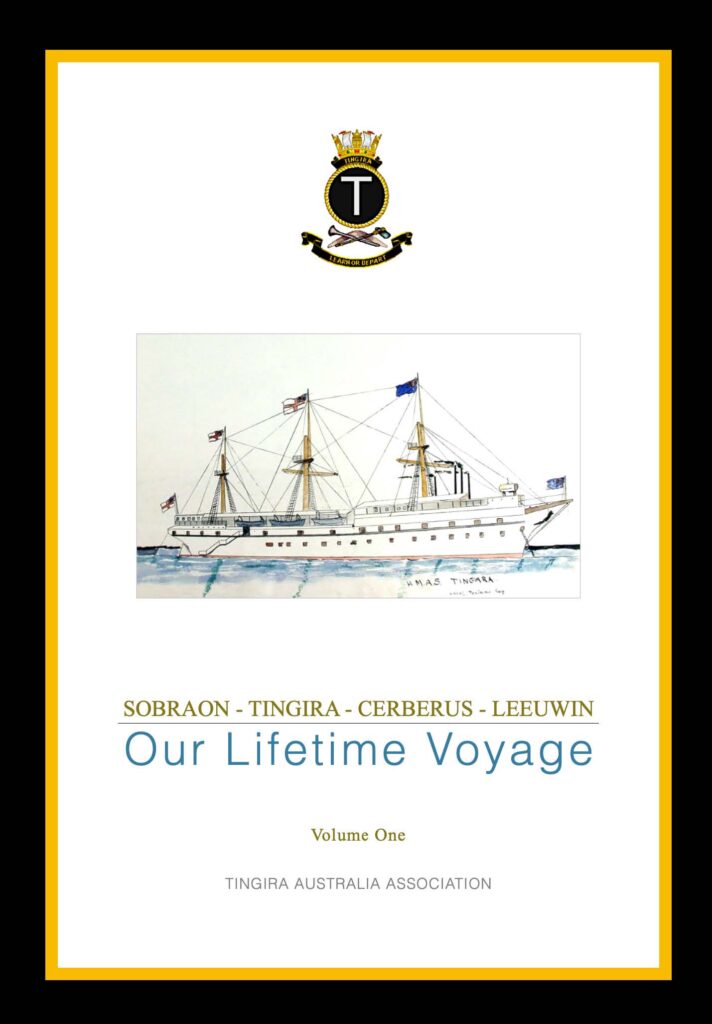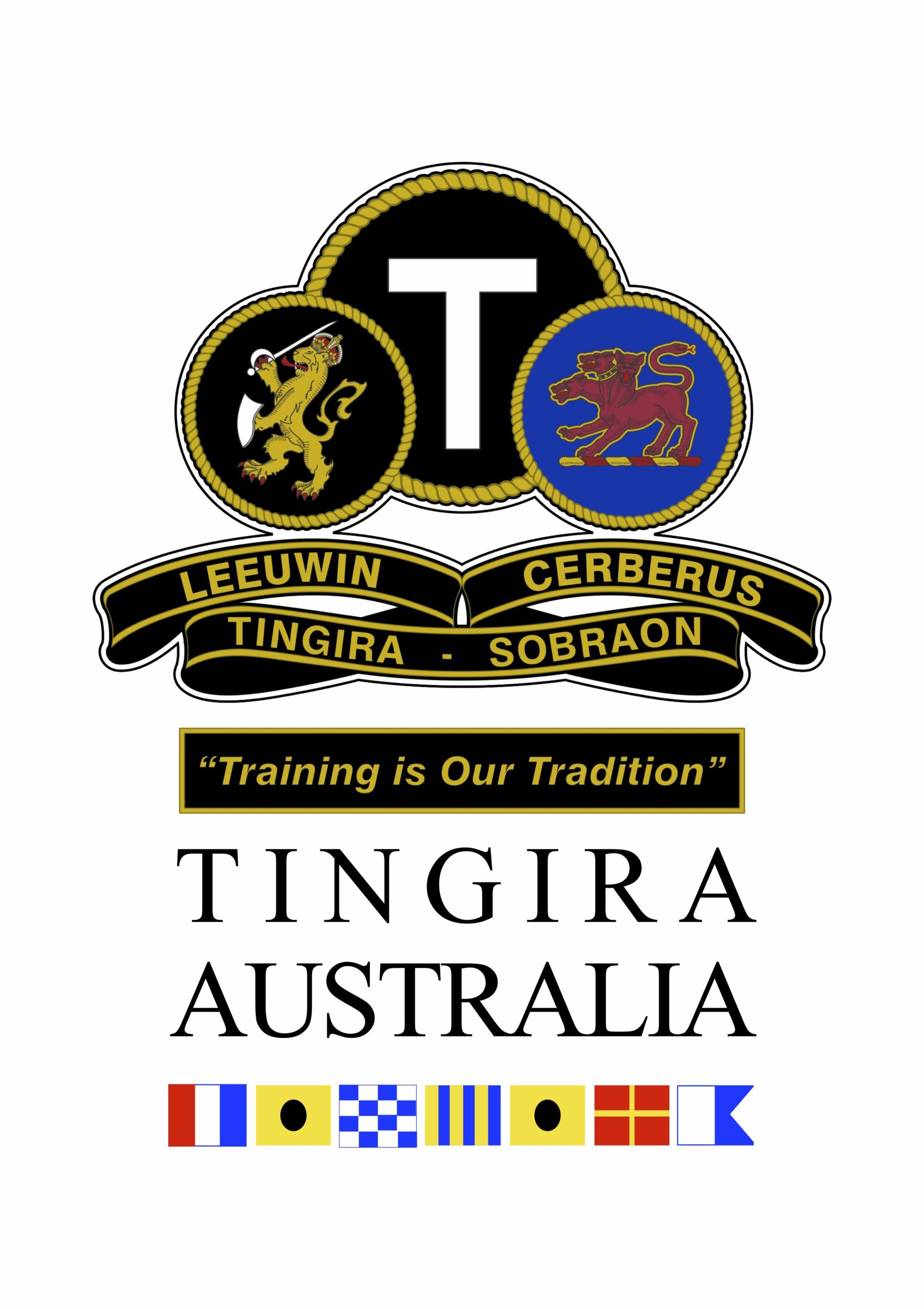SOBRAON – TINGIRA – CERBERUS – LEEUWIN
Our story so far…
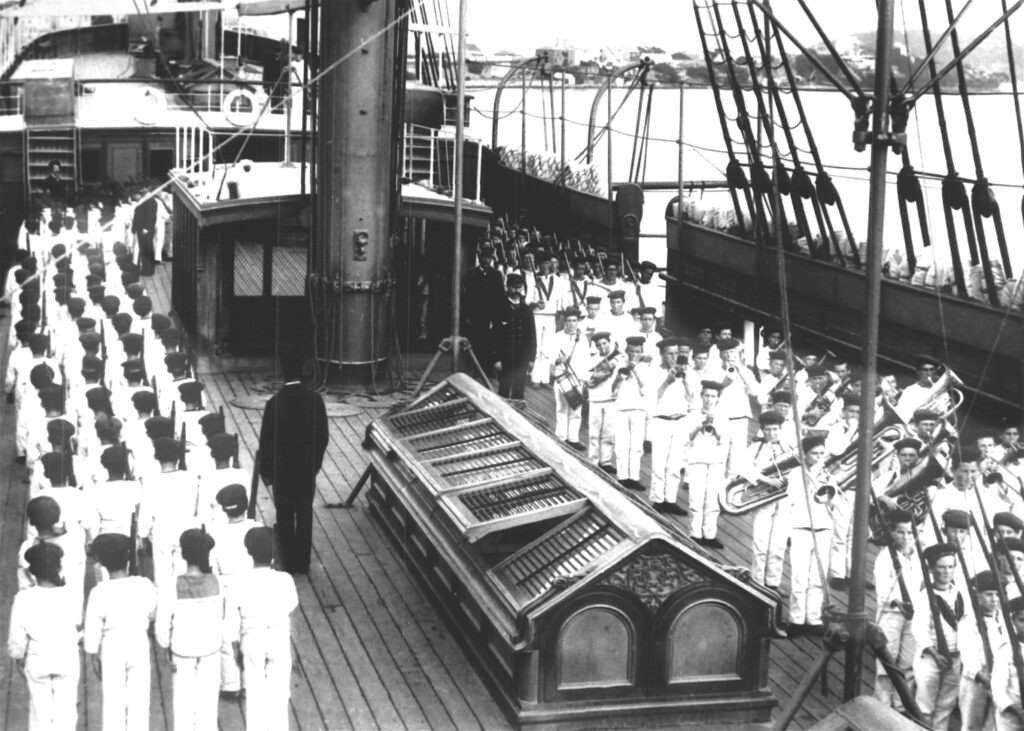
“Of all the great ships of Her Majesty’s Australian Navy, the ship which has possibly received the least acclaim, and yet the one which should receive high honours, is HMAS Tingira.
Tingira, an aboriginal word for ‘open sea’, was originally the clipper sailing ship Sobraon, built in the yard of the famous shipbuilder, Alexander Hall of Aberdeen. Sobraon was launched in 1866 and was the largest composite ship ever built in her time”.
RAN Historical Society
CLIPPER SHIP SOBRAON
For 24 years she sailed between England and Australia and her Commander, James Aberdour Elmslie RNR, earned the utmost respect from his sailing fraternity and all those who ventured the seas to place their lives in his capable hands. Captain Elmslie never unduly stressed his ship or her passengers in his 24 years as Commanding Officer of Sobraon.
The NSW Government in 1891, negotiated with Sobraon’s owners Devitt and Moore, to purchase her after she had reached Melbourne, in January 1891. Sobraon was towed to Sydney Harbour, arriving there on 15 February 1891. This action by the Government to purchase Sobraon had been brought about because a ship had been urgently needed to replace the SHIP Vernon, an old Blackwaller which had been acquired in 1867 to act as a floating reformatory for boys who had been dispatched to her under the regulations which emanated from the Act for the Relief of Destitute Children, the Act to Establish Juvenile Reformatories and the Public Schools Act of 1866.
NAUTICAL SCHOOL SHIP SOBRAON
The Vernon had been lying at anchor off Garden Island until 1871, when she was towed to the confluence of the Parramatta and Lane Cove Rivers, where she was moored off Cockatoo Island, then named Biloela, an Industrial School and Reform School. Sobraon was placed in Sutherland dock. Cockatoo Island for an inspection and complete refit.
She was found to be as sound as a bell and by October 1892, after £31,429 had been spent on modifications, the great ship was prepared to enter the second stage of her life as a Nautical School Ship. The sole purpose was for underprivileged boys whom the NSW court had found destitute, or for other reasons saw it fit to hand these boys into the strict, disciplinary life on board Sobraon under the careful control of Superintendent Frederick William Neitenstein, Lieutenant William Henry Mason, and their officers.
Apart from being disciplined, the boys were given the opportunity to develop their skills as tradesmen and were inculcated with a basic education both moral and academic. They formed a band that was in much demand on many an important ceremonial occasion, and such was the standard of their tuition and development that some of the lads found positions in orchestras. Indeed, many of them attained acclaim, both at home in Australia and overseas, in the field of sport as well as music.
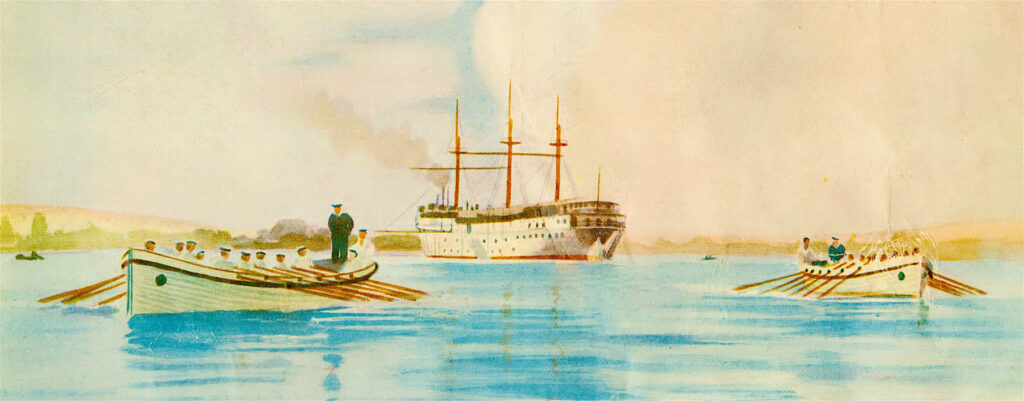
The motto of the Tingira Old Boys Association
“In strength and unity, this Association will stand forever”
One boy, champion swimmer, Bernard Kieran, born in NSW went on to be a swimming sensation, winning races and breaking world records aged 19. At home on leave in Brisbane, Bernard died from appendicitis, the nation was in mourning. He was given a State funeral by the NSW government, his gravesite at Gore Hill, Sydney, is maintained and annually visited by members of the present Tingira Australia Association.
The aim of this exercise was to encourage young lads to join the navy or merchant service which at this time was undergoing a dramatic change, as steam was gradually winning the race with wind-propelled ships.
In 1911 the NSW Government, which had been constantly studying the means of making progress in the treatment of children whose young lives were disadvantaged, decided to dispose of the ‘ Nautical’ type of reform in favour of a land-based system. Accordingly, Brush Farm was purchased at Eastwood, NSW. It was here that the boys from the Sobraon were housed until an establishment at Mt. Penang was constructed in 1912. It is interesting to note that the porch at the entrance to the main building is known as the quarterdeck. Today in 2020, the City of Ryde, Sobraon Street leads towards Brush Farm NSW Corrections training facility.
Sobraon was then sold to the young Commonwealth Government for £15,000. In 1890, the Premier of NSW, Sir Henry Parkes, initiated moves towards the federation of the Australian states, which led to the formation of the Commonwealth of Australia being decreed on 1st January 1901.
In March 1901 the naval forces and establishments of the State Governments were transferred to the Commonwealth, but the States continued to administer them under State Acts and Regulations until February 1904, when the Commonwealth Defence Act came into force. An amending Act, decreed on 12 January 1904, led to the establishment of a Naval Board of Administration, with Captain W. R. Creswell as Director.
Now in 1909, a proposal for Australia’s naval defence emanated from the Imperial Defence Conference; the Pacific Fleet was to be formed of three units, one attached to the Australian Station, one attached to the East Indies, and one to the China Station, which was also to defend New Zealand. The East Indies and China units were to be under the British Admiralty’s control, while the Australian unit was to be paid for and controlled by Australia, and was to be eventually manned by Australians. In 1910 the Naval Defence Act was passed and in October 1911 the adoption of the title ‘Royal Australian Navy’ was authorised by King George V.
This same year saw the launching on the Clyde of HMAS Australia and the purchasing of the Sobraon by the Commonwealth of Australia. Sobraon was again placed in the hands of Cockatoo Docks for an extensive refit. She was again found to be as sound as a bell at the ripe old age of 55.
HMAS TINGIRA
The stage was set for yet another honourable role in the long life of this ship Sobraon, at 8 o’clock on the morning of 25 April 1912, just three years before the famous Anzac Day, the RAN White Ensign flag was hoisted to commemorate the commissioning of HMAS Tingira the first naval training ship in the Royal Australian Navy. Tingira, an aboriginal word meaning ‘ocean’, or ‘open sea’, and pronounced Tinguy-rah. HMAS Tingira became the training ship for thousands of young boys who choose the Navy as a career under the Department of the Navy’s new boy enlistment scheme.
Though all those who trained in her went to sea, the Tingira did not — instead, she swung at her moorings in beautiful Rose Bay, opposite Lyne Park, for the next 15 years. The commissioning Captain of HMAS Tingira, Commander Lewin RN, who, with his first lieutenant, Lieutenant Commander Browne, RN, and Executive Officers Dean and Seaton, were the first of a long line of distinguished men who had been carefully chosen for their special ability to impart knowledge and instruction to sturdy, self-reliant, intelligent boys.
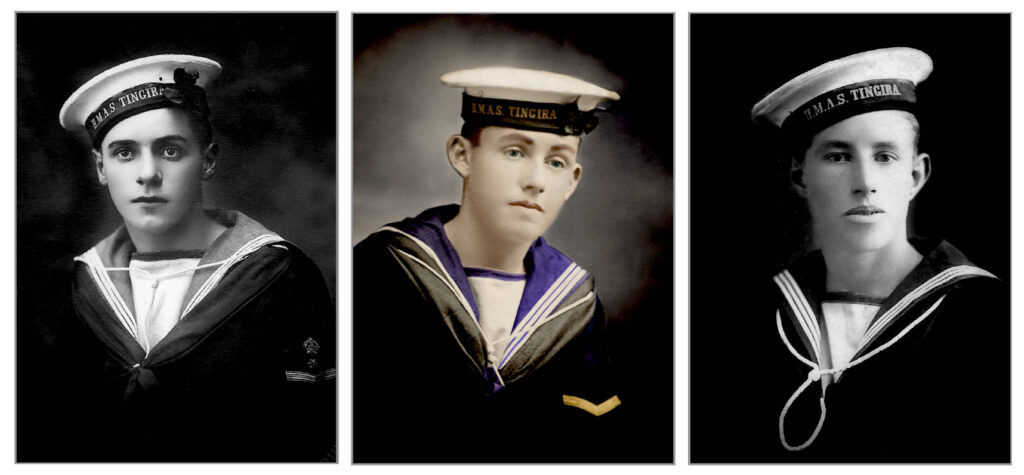
Arriving onboard Tingira, the boys were immediately assigned an official number which remained with them throughout their naval service. They were then placed in either the ‘port’ or ‘starboard’ watch and kitted up in what was termed casual clothing. This was an interim naval kit consisting off a cap, duck suit (coarse white material), towel, soap, hammock, and blankets. Shoes were only ever worn when undertaking parade or gunnery training or when going ashore for Sunday divine service. A more complete kit-up usually followed a week later.
Boys as young as 14 were trained in Tingira between 1912 and 1926. Boys were placed in classes of about 12 and for the first four months, they received comprehensive instruction in seamanship. On completion, they would sit an examination before beginning their gunnery training. This was where discipline reportedly came into its own.
Everything was done at ‘the double’ and failure to carry out a correct drill or any order with alacrity was severely dealt with. A typical day’s routine for a Tingira boy saw them turn out at 0530 and ‘lash and stow’ their hammocks before mustering for baths and showers. After bathing, each boy would receive a cup of cocoa, known as ‘ki’, before ‘turning to’ and cleaning the ship. Boats would then be turned out and on completion, the boys would fall in for physical training. The last boy to fall in would be sent over the ship’s rigging half a dozen times which was never a pleasant prospect, particularly with no footwear on a cold, frosty morning.
Boys aloft in Tingira’s rigging and scaling it was a daily event for most boys. After a vigorous half an hour of physical training all of the boys would be ordered over the ship rigging three times before mustering for breakfast. Grace was said before all meals which were overseen by the ship’s padre. On completion of breakfast, the day’s classroom and practical instruction began, continuing until 1600 at which time the boys turned their attention to domestic duties or compulsory organised sport. At 1900 hours, on completion of supper, the boys were allowed to write letters or participate in voluntary games until 2030 when they were fallen in before being ordered to ‘turn in’. Lights out occurred promptly at 2100 hours.
The first intake of boys took place between 1 June and 28 June 1912, and at the time of Tingira’s decommissioning, 3,168 boys were trained in Tingira and most took their place as sailors in the fleet. Many served in the RAN during the two World Wars and some, such as Signalman J. W. Varcoe, DSM, and Petty Officer J. T. Humphries, GM was decorated for individual acts of gallantry during those conflicts.
The last draft of the Tingira boys began their training in 1926 and in August of that year recruiting of boys ceased. On 30 June 1927 Tingira paid off and after passing through the hands of a number of different owners she was report-ably later broken up off Sydney Heads in 1941. In 2017 it was reported by The Australian Maritime Museum, that a satellite image was taken of a large steel rib cage of an old ship buried in the shallow sands of Balls Head, Sydney Harbour. The dimensions of this sand submerged ship’s ribs in width and length matched the size of HMAS Tingira. Maritime authorities believe the hulk of Tingira was so low in the waterline with every shackle taken from her decks, that she never did make it back to sea and rotted in the shoreline sands at Balls Head. Tingira was the first and possibly the only clipper ship to have steel ribs as she was at first designed to be a new ship of steam in the mid-1860s, then new owners midway in construction decided for her to remain with sails.
These young Tingira boys (known locally in Sydney as the Tinny Boys) had had the privilege of having their initial training, not on a shore establishment, or a stone ship that didn’t rock, but in the safe confines of one of the finest ships ever built.
Many Tingira boys went on to serve long careers in the RAN. Most served time onboard HMAS Australia in the WW1 conflicts and many also served as senior sailors or Officers on the second HMAS Australia during WW11. After the war, the Tinnie Boys formed the ‘Tingira Old Boys Association’.
2011 – Tingira Australia Association Secretary, Mark Lee, proudly presented the last living Tingira Boy, Dan Bowden, aged 103, with an Honorary Gold Life membership of the new Tingira Australia Association. Dan sadly passed a month later and said he was glad to see his dream the “Tingira was never going to die” we owe nothing more than that dream to these Tinny boys.
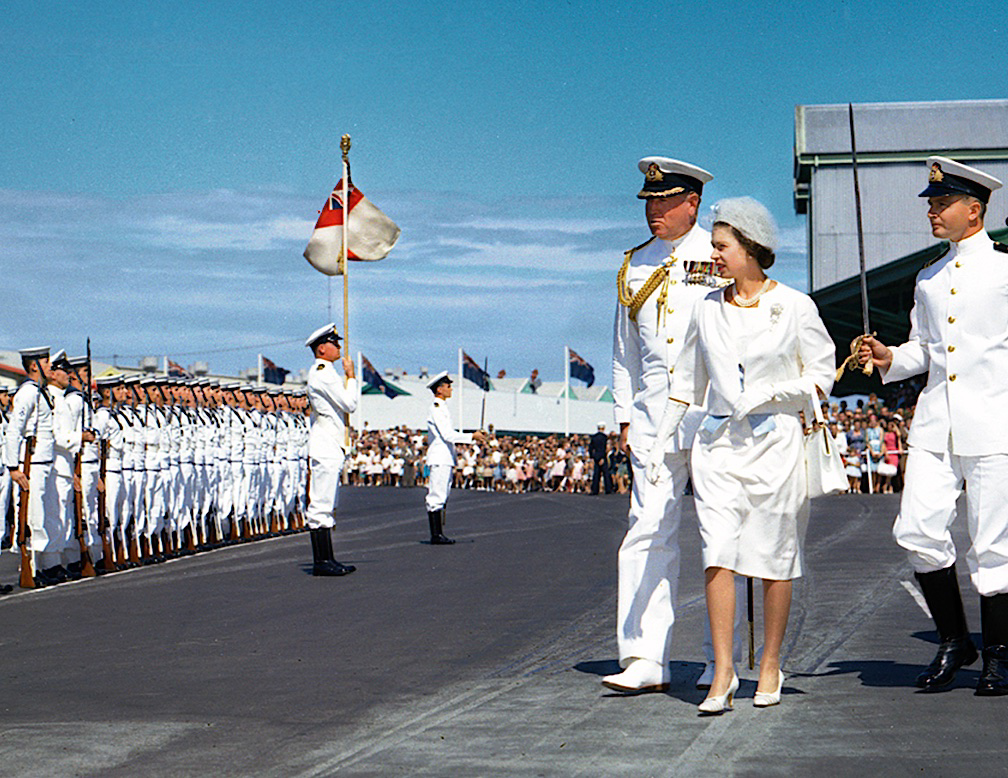
HMAS LEEUWIN
Initially, a navy shore establishment, Leeuwin was commissioned in August 1940 as the naval depot for Fremantle. This original facility was centred around a drill hall constructed in 1926 in East Fremantle, Leeuwin was relocated in 1942 to Preston Point, on the other side of the Swan River. The base was adopted for use as a training facility after World War II, initially for navy reservists and national servicemen.
The base was reclassified as The Junior Recruit Training Establishment (JRTE) in 1960: boys would normally join the navy from the age of 15, and the Junior Recruit Training Scheme (JRTS) served to give them a year of secondary education along with basic naval training, before sending them to other bases for training in their specialty. The first RAN Junior Recruits (JR’s), boys aged between 15 and 17, commenced training at HMAS Leeuwin, Fremantle, Western Australia on 13 July 1960. Several intakes transferred to HMAS Cerberus, Victoria, during the new construction period in the early ’60s.
The scheme continued for 24 years until 1984, with over 12,000 Junior Recruits graduating from HMAS Leeuwin. Many of these young JR’s served lengthy careers in the RAN, with many reaching senior sailor and commissioned officer rank. One Junior Recruit, Russ Crane from the 32nd intake went on to become Vice Admiral, Chief of Navy in 2008 after serving for 41 years continuously. It is believed between the Tingira boys and the Junior Recruit boys have represented our country in every battle and confrontation that Australia has been involved in since the Federation.
Education and training of Junior Recruits were shared with the Royal Australian Naval College at HMAS Creswell, located in Jervis Bay, NSW. The first JRTS (Junior Recruit Training Scheme) intake consisted of 155 recruits, and by the end of the first decade, over 800 junior recruits and 100 Officer Candidates were in residence. The first initial intakes were trained at HMAS Cerberus, Crib Point, Victoria, whilst the construction of HMAS Leeuwin extensions took place.
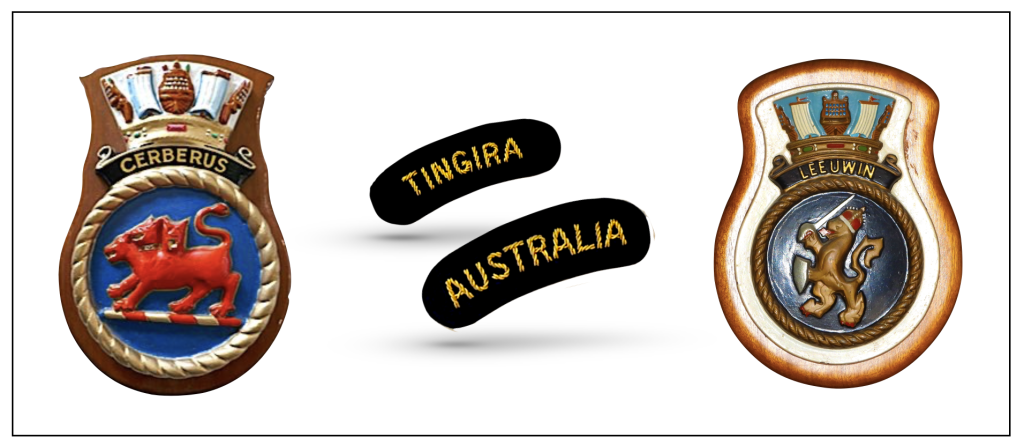
In many ways, the JRTS concept and training were modelled on the navy boys training ship HMAS Tingira, (1912-27), which also had trained boys aged 14 to 16 for service in the navy at the beginning of the RAN in 1912. A similar junior sailor scheme also operated in the Royal Navy, with young boys sent to sea training onboard HMS Granges in 1865.
The Boys of Leeuwin were also linked to their former ‘Tingira brothers’ by wearing a Tingira shoulder name flash on all their uniforms whilst at HMAS Leeuwin. They took on many other familiar roles similar to the Tingira boys bonding relationships with the local Fremantle communities in weekend sporting and social activities. The Leeuwin boys would also enjoy Saturday morning leave at the local Flying Angel Seafarers Club in Fremantle or a last late moment with the 8 pm Sunday night dance at the Flying Angel Club attended by many of the local nurses from the Fremantle Hollywood hospital.
The Leeuwin boys had a sponsorship scheme during their 12-month stay. They would spend 48 hours in the care of a local family, some former navy members, some just taking a boy in for the first time. Lifetime friendships and bonds were made with Fremantle communities by the Leeuwin boys, great memories and moments for all.
HMAS Leeuwin was permanently closed in 1984, after having educated 12,074 navy recruits: improving their quality of education meant that the RAN no longer felt the need to provide secondary education to those wishing to join the navy.
HMAS Leeuwin was decommissioned as a naval establishment on 11 November 1986. One of several RAN facilities closed during the late 1980s and early 1990s because of funding cuts and the rationalisation and consolidation of Defence shore bases.
The facilities remained in the possession of the Australian Defence Force and were later reopened as Leeuwin Barracks, a facility of the Australian Army. Leeuwin Barracks provided support for personnel of all three branches of the Australian military in the Fremantle area through to 2018 when the Army moved onto new local facilities. The property is now under the care of the Australian Government and is being prepared for sale in 2023 with the site most probably redesigned into a mini foreshore city.
However, one last memory will remain for many more decades at the Leeuwin site. A new JR Memorial, flagpole, and garden beds were established by the former JR’s at the 50-year JR Reunion in 2010, in dedication to all former Tingira Boys and Junior Recruits from the HMAS Cerberus and Leeuwin JRTS.
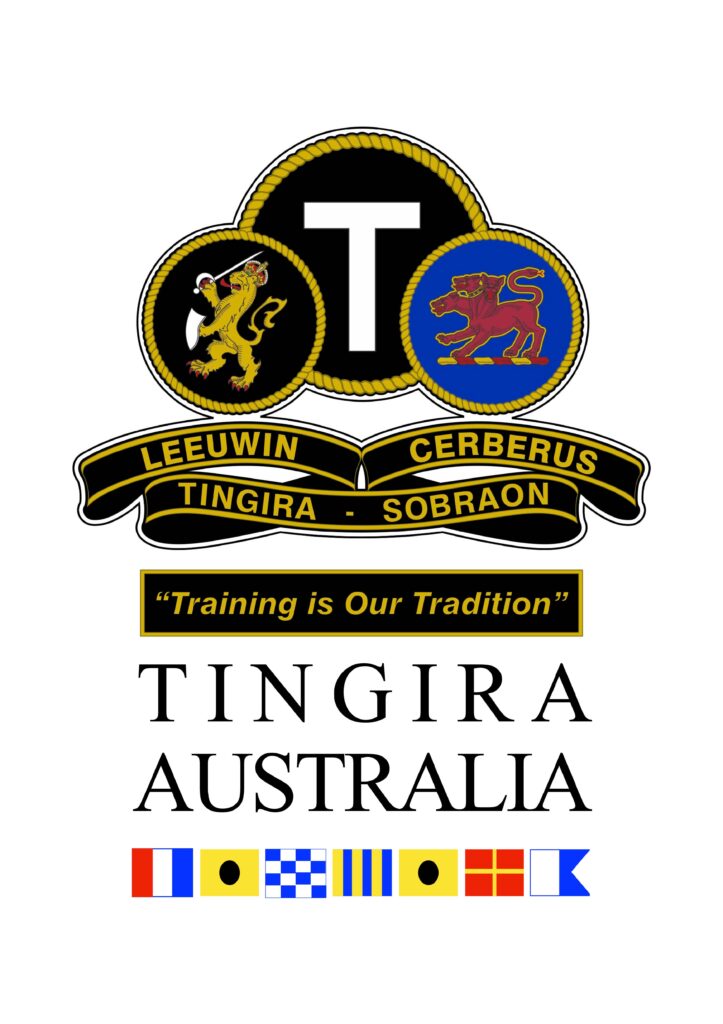
Ships Crests of HMAS Tingira, Leeuwin and Cerberus 1-1-11
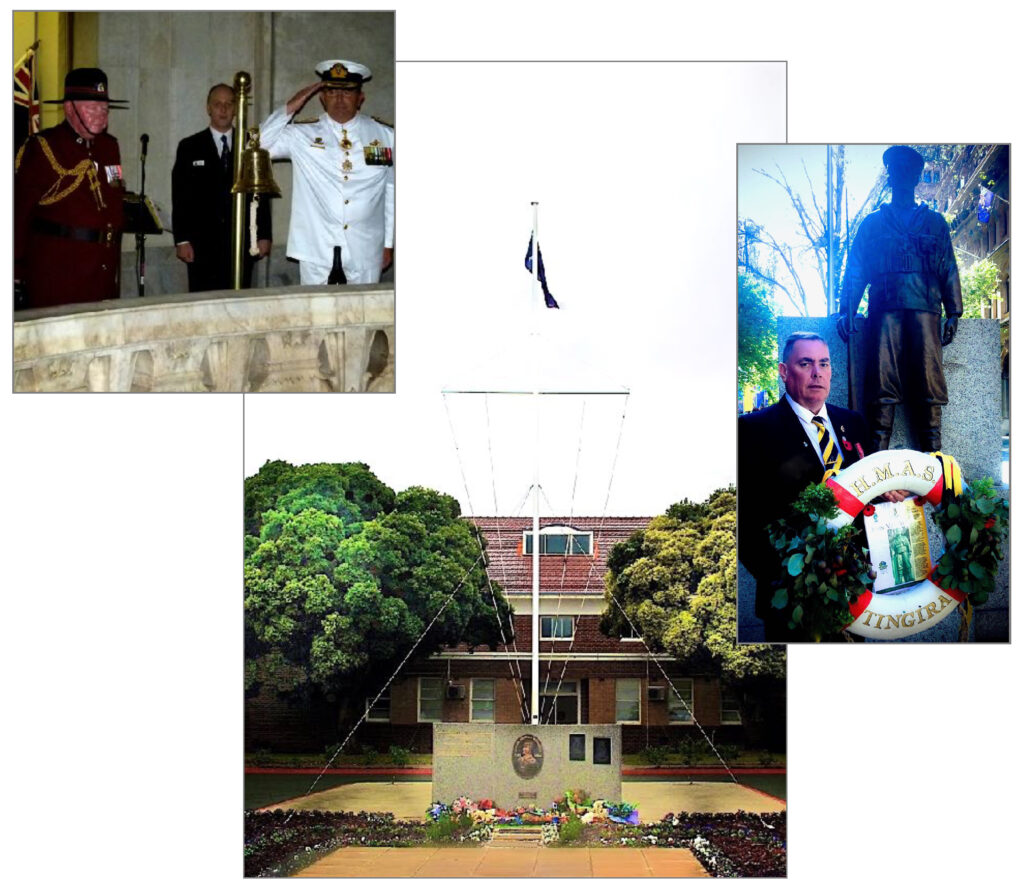
Tingira Australia Association President, Lance Ker, lays the ‘Tingira Centenary Wreath’, Martin Place Cenotaph, Sydney, with Tingira Boy, 11-11-18 , John Varcoe, the bronze sailor on the Cenotaph
Junior Recruit Memorial, New flag pole and JR Memorial christened at the occasion of the 2010 JR Reunion Leeuwin Barracks, East Fremantle, Western Australia. 13-7-10
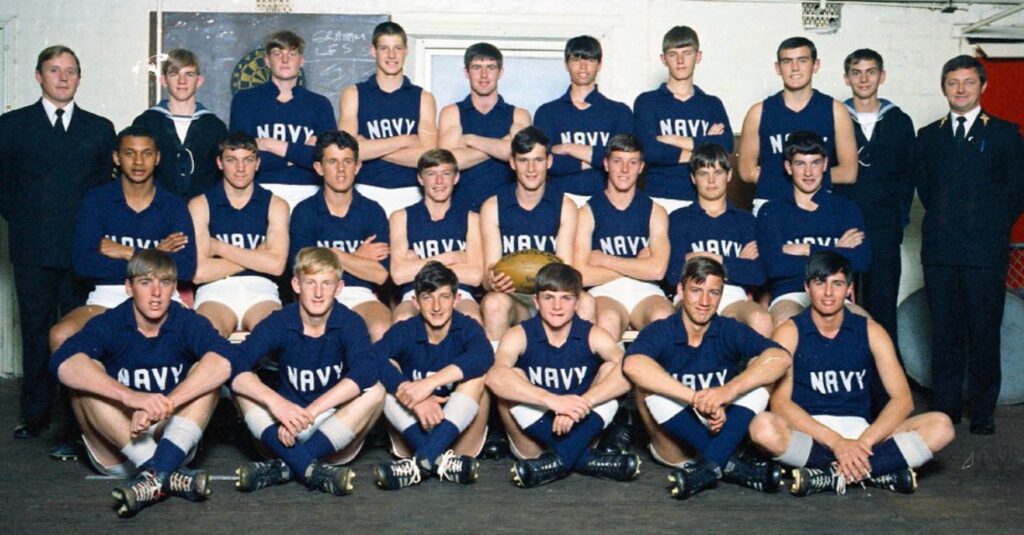
TINGIRA AUSTRALIA ASSOCIATION
In July 2010 over 1,000 former JR’s gathered at Leeuwin Barracks with partners to celebrate the first 50 years since the initial first intake went through the gates on 13 July 1960.
With the commissioning of the JR Memorial a highlight at the week-long reunion, a good time was had by 550 JR’s with partners at the gala dinner held at Burswood casino on Perth’s foreshore. Stories, dancing and many old and new handshakes were made, what a night, what a week as many boys reunited for the first time in decades.
It was here that gala dinner that former JR’s Russ Crane, 32nd intake and Mark Lee, 45th intake, decided after a short conversation that it would be a good idea to “keep the boys together” and form a new association to be known as the ‘Tingira Australia Association’ bound and bonded on making new and renewing old friendships.
Russ Crane and Mark Lee had several long night meetings back in Sydney. They recruited a team to start the two-year steering committee and set a strategic plan for the new association, these were the new ‘Tinny Boys’. They would be known as Tingira as they grouped the Cerberus and Leeuwin recruit all as one, and none with any rank, all would be known as JR’s.
JR Chris Perrin, 46th, was the first to step up and volunteer to be the inaugural President, followed by JR Greg Read, 12th, followed by JR Lance Ker, 78th, who is the current serving President. Russ Crane was asked to be inaugural Tingira Patron, Mark Lee has served the role of Secretary since the day the association was incorporated, 1 January 2011.
An inaugural steering committee was established with Chris Perrin as President. The association was most grateful to receive a donation of $11,694 from Ian Dunn, Trevor Cangemi, and Alan Rodgers, of the 2010 JR Reunion committee, the remaining proceeds from their JR Reunion Dinner function. The Tingira committee also established the ‘Foundation Life Membership’ funding status, to stay in place for the first decade of the association to keep the association financially alive.
The association has made new relationships with the RSL Rose Bay sub-branch when they discovered the ‘Tingira Memorial’ on the site of where the former ship training HMAS Tingira, where she swung on the anchor for many years.
ANZAC Memorial has been a host to several of the Tingira association formal activities including the first event when the Chief of Navy, Russ Crane commissioned their own Tingira bell. HMAS Tingira was never given a bell, she used the three Sobraon bells for her entire naval period, brass was very scarce in times of war.
The association has also established a Statewide Coordinator network in most capital cities, where the Tingira boys march under their banner on ANZAC Day and celebrate the Tingira birthday on 13 July each year. A member of the committee executive represents the association at the national Coral Sea commemoration in Canberra annually, many Tingira Boys served on both HMAS Sydney and HMAS Australia in WWI and WWII.
Over 200 members attended the initial 2015 JR Reunion in Sydney. The proposed 2020 JR Reunion, celebrating the 60 years since JR’s walked through the gates of HMAS Leeuwin to be held in Perth was recently cancelled due to the international COVID outbreak. The upside was the publication of the two-volume set of books by the committee “Our Lifetime Voyage’.
AGM 2021 – Lance Ker became the first ‘Chairman’ of Tingira Australia Association, with the election of former RAN Junior Recruit, Brad Murphy, as the new President to lead the association for the next three years.
Tingira Australia Association President Brad Murphy, was re-elected for a second three-year term to lead the Tingira National Committee, with Jeff Wake as his Vice President, at the 2024 Annual General Meeting.
“ Long Live Tingira – Mates for Life ” – Our story so far.
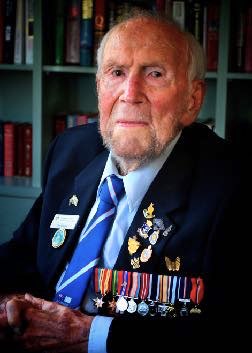
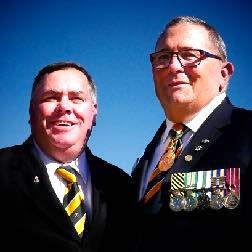
Patron Russ Crane
